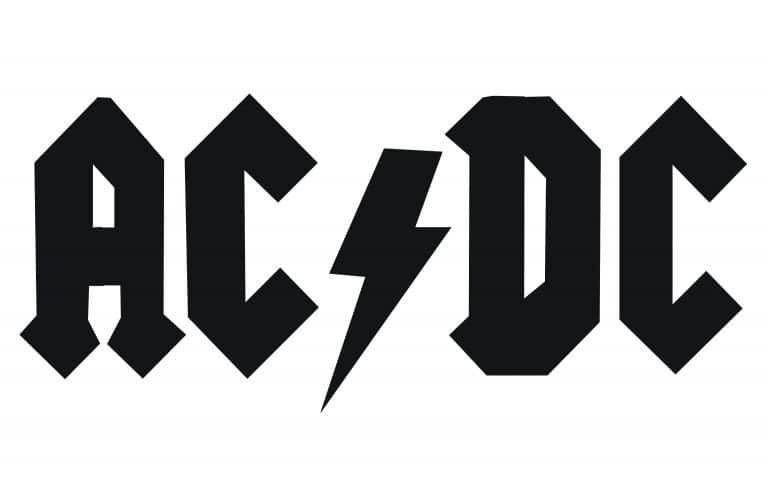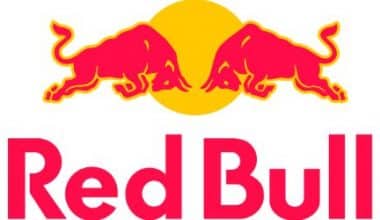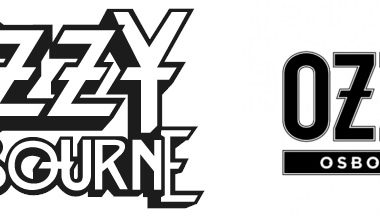The AC/DC logo is one of the most recognizable logos in the world. It is simple, yet effective, and it perfectly captures the energy and attitude of the band. The logo consists of the band’s name in a bold, stylized font, with a lightning bolt separating the two words. The lightning bolt is a symbol of power and energy, and it perfectly reflects the band’s sound. The AC/DC logo has been used on the band’s albums, merchandise, and live shows for over 40 years, and it continues to be one of the most popular and iconic logos in the world.
But to give you a clearer understanding of how this logo came to be, this article will explore the history of the AC/DC logo, from its creation in 1977 to its current status as one of the most recognizable logos in the world. We will also discuss the symbolism of the logo and its impact on popular culture.
What is AC/DC?
AC/DC is an Australian rock band that was founded in 1973 in Sydney. Angus and Malcolm Young, guitarist brothers, formed the band. The legendary band’s repertoire includes various rock and heavy metal genres. High Voltage, their debut album, was released in 1975. The lineup of the band has changed frequently, with Angus Young being the only original member.
What Does the AC/DC Logo Represent?
The iconic ACDC logo is easily recognized, in part, because the name is part of the logo. Gerard Huerta, a graphic designer, collaborated with Atlantic Records’ art director Bob Defrin to create it.
Huerta chose the lettering style he saw in the Gutenberg Bible. The AC/DC brothers decided on this name after seeing the “AC/DC” inscription on their sister’s sewing machine. This is an abbreviation for Alternating Current, Direct Current. The logo has since become an important part of pop culture, transcending the band and its sound.
Who Created the AC/DC Logo?
The current ACDC logo was designed by Bob Defrin, the art director at Atlantic Records, with the assistance of renowned graphic designer Gerard Huerta and debuted in the summer of 1977. The lightning bolt from the previous version has been replaced with sharp, carefully crafted Gothic lettering chosen by Huerta.
After more than 40 years, the logo has become inextricably linked to the image and concept of the rock band. The combination of blunt, bland, and white creates an electrifying mix of enthusiasm, courage, energy, and perfection.
The History of the AC/DC Logo
Between 1974 and 1977, four logo versions were created for AC/DC. Three major redesigns culminated in the current logo, which has remained unchanged since 1977. The band’s iconic symbol, a lightning bolt between the two parts of their name, was adopted in 1974 and was inspired by their debut album “High Voltage.” Except for the 1976 version, which featured a slash sign in place of the bolt, it has appeared on all of their emblems.
1974 – 1976
The first ACDC logo, created in 1974, featured the band’s name in an extra-bold sans-serif stencil font, with the black letters separating a sharp, red lightning bolt. The letters and symbol were crammed together, but the overall look was fresh and balanced thanks to the wide stencils.
1976
The color scheme of the logo was changed to black and yellow in 1976. To replace the original san-serif stencil, the designers chose a smooth serif typeface. The “AC” portion was now angled to the right, while the “DC” portion was angled to the left. The lightning bolt was changed to white with a double black and yellow outline to balance the outline of the arched letters.
1976 – 1977
This was the only version of the band’s logo that did not include the lightning bolt, and it was designed for their third studio album, “Dirty Deeds Done Dirt Cheap.” To evoke a sense of energy and motion, the letters were changed to a bright pink and black in a handwritten sans-serif typeface with smooth, rounded letters and a thick black outline.
1977
The iconic ACDC band logo that we see today debuted in 1977. The stylish geometric typeface with angled letters and rhombuses at the end of the letter “A” featured a slightly enlarged lightning bolt between the two parts of the logotype. The monochromatic palette allows the logo to be easily placed on a variety of backgrounds while retaining its robust character.
Colors and Shape
The AC/DC logo features a Gothic font style derived from Gutenberg’s Bible. Huerta cleverly used lettering to complement the biblical mood of the “Let There Be Rock” album and, in particular, the title. The logo has been in use for nearly 40 years and has become inextricably linked to the band’s image and concept. The stark contrast of black and white produces an electrifying chemistry of ardor, energy, bravery, and perfection. The band’s name actually stands for “alternate current/direct current.”
The primary AC/DC logo’s heavy lettering has already become iconic. Its custom gothic-style font, with geometric serifs on the ends of the lines, is similar to typefaces like Metallica Black and Graveblade Regular.
On the other hand, in terms of the color palette of the AC/DC visual identity, the band has used its logo in black against a transparent background for the majority of its history. The black inscription is always powerful and brutal, exuding timelessness and confidence.
AC/DC Band Brothers’ History
The band was founded by Malcolm and Angus Young, though Angus attributed the band’s formation to his brother. Malcolm announced his retirement from the band in 2014 due to dementia, and he passed away in 2017.
The AC/DC Band Structure
The Young family arrived in Australia from Scotland during a cold winter in 1963, allegedly through an assisted immigration scheme. The family had been living in poverty for many years because the father was constantly unemployed. That winter was the coldest on record, and with temperatures below zero, the family couldn’t pass up the discounted one-way tickets out of the country.
The Young family was large at the time, with seven children and two parents, and they had to make do with living in a makeshift tin hostel. George formed the “Easybeats” band and practiced in the laundry room.
Their efforts were rewarded two years later when the band was offered a recording contract. It followed with “Friday on My Mind,” Australia’s first international hit. Due to their global success, the band relocated to the United Kingdom in 1966, but their success did not last long. The Easybeats finally broke up in 1969, and as if things couldn’t get any worse, the band was deeply in debt.
Read Also: St. Louis Cardinals Logo: History, Meaning, Evolution
While George was still reeling from the failure of his band, his brothers were still in school but not doing well. Malcolm had gone to Glasgow school and was constantly involved in fights. Angus enrolled at the school, but Malcolm’s precedence was not in his favor.
On his first day of school, Angus was caned to discourage him from fighting. Given the family’s poor reputation, Angus was finally given the option of leaving or being expelled from school.
All of this worked out in their favor because when George returned to Australia in 1973, he asked both of his brothers to form a new band with him. At the time, their sister Margaret had a sewing machine with the letters “AC/DC” on it, which stood for alternating current/direct current. They adopted these initials as the name of their band, and thus AC/DC, the band, was born.
AC/DC Becomes a Well-Known Band
The band formed in late 1973, and they added new members in various capacities, including lead vocalist Dave Evans. Unfortunately, Dave only lasted about a year because the brothers felt his voice did not fit their rock sound. Their band manager agreed, and Bon Scott was brought in to replace him in 1974.
The band then toured the country and relocated to Melbourne, where it released an album every year with the help of George and his writing partner Harry Vanda. High Voltage, their ground-breaking album, was released in ten days in October 1974.
The band had settled down by that point, with each member taking on a specific role. The guitarists were Malcolm and Angus, the lead vocalist was Scott, the drummer was Michael Rudd, and the bassist was Mark Evans. In August 1974, they made their debut, where they met promoter Michael Browning, who took a chance on them.
Breakthrough in AC/DC
The band’s first big break came with its collaboration with Mutt Lange, who produced its sixth studio album “Highway to Hell” in 1979. Eddie Van Halen recalls this as his favorite AC/DC album, along with Powerage.
The album was the band’s first to reach the top 100 in the United States, peaking at No. 17, and catapulted them to the top ranks of hard rock acts. The lyrics on the album leaned toward more central rock themes, a departure from their more flippant, comical style.
Before being struck by tragedy, the band began work on its seventh album “Back in Black” in 1980. Scott passed out in his car on the way back from a friend’s house in February 1980, after a night of alleged drinking and drug use. According to the friend, Scott was unable to move when he arrived at his house, so he was forced to leave him in the car overnight.
Changes in the AC/DC Lineup and Commercial Decline (1983-1989)
For its ninth album, “Flick of the Switch,” released in 1983, the band parted ways with producer Mutt Lange. However, the album was widely regarded as a failure, with critics describing it as underdeveloped. One critic remarked that they had created “the same album nine times.” Later, the band was voted the eighth-biggest disappointment of the year in a readers’ poll.
AC/DC’s Popularity Returns (1990-1998)
“Razors’ Edge,” the band’s twelfth studio album, was recorded in Vancouver, BC. Mike Fraser produced and mixed the album, which was also produced by Bruce Fairbairn.
The album was released in 1990 and was a huge success for the band, with hits like “Are You Ready” and “Thunderstruck,” which charted at No. 16 and No. 5 on the Billboard Rock Chart, respectively, as well as “Moneytalks,” which charted at No. 23 on the Billboard Hot 100.
The album was certified multi-platinum and charted in the top ten in the United States.
Confirmed AC/DC Popularity (1999-2013)
In Vancouver, AC/DC recorded its 14th studio album, “Stiff Upper Lip,” which was produced by their brother George Young. The album received a positive response from critics after its release in February 2000, though it was criticized for lacking new ideas.
The Australian release of the album included a bonus disc containing a few promotional videos and several live performance recordings made in Madrid in 1996. The album debuted at the top of the charts in five countries, including Germany and Australia. The lead single, “Stiff Upper Lip,” spent four weeks at the top of the US rock charts. In March 2000, the band performed the same song on Saturday Night Live.
The band signed a multi-album long-term deal with Sony Music in 2002, and several of its remastered albums were later released. Each release included a larger booklet containing rare photos, notes, and memorabilia.
Except for the last two albums, the band’s entire back catalog was remastered and reissued in 2003. Ballbreaker and Stiff Upper Lip would be released later in 2004. In 2003, the band was inducted into the Rock and Roll Hall of Fame.
AC/DC Reunion and Power Up
The band updated its social media accounts in September 2020 with a video clip of a neon light shaped like its lightning bolt symbol. This fueled speculation that the band was planning a comeback in the next two weeks. The band’s website was redirected to a new address the next day and was updated with an online shop and an email sign-up form. The band then released another teaser video, fueling speculation about a possible reunion.
AC/DC finally confirmed the reunion of former members Brian Johnson, Cliff Williams, and Phil Rudd, as well as brothers Angus and Stevie Young, in late September 2020. On October 1, it released a snippet of its new song, “Shot in the Dark,” which piqued the interest of fans.
Final Thoughts on AC/DC’s History
AC/DC is one of the most successful bands in history, selling over 200 million records worldwide and ranking fifth in US sales, ahead of Mariah Carey and Madonna. The ACDC logo has remained unchanged since 1977, but it has only grown more iconic and recognizable over time. Even a street in Leganes, Spain, was named after the band.
Although the band has achieved enormous success, it has also received considerable criticism, with some viewing its songs as simplistic, deliberately lowbrow, and misogynistic. This hasn’t stopped the band’s fans from defending its music as “bawdy humor,” while the band members have generally dismissed such claims.
Overall, AC/DC is still a popular band around the world, and with its recent reunion, fans are excited to see what’s next.
Related Articles
- CHARGERS LOGO: Facts That You Didn’t Know About The Chargers Team
- QUEEN LOGO: The Real Meaning, History, and Why There Is a Bird in Queen Logo
- TAMPA BAY LIGHTNING LOGO: History and Everything you Need to Know
- Vogue Logo: What is the Meaning of the Brand?
- Ralph Lauren Logo: Evolution, History & All You Need
- Michelin Man Logo: The Story Behind the Logo
- Kobe Bryant Logo: The Story Behind His Legacy






